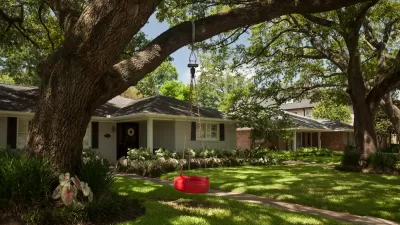An Ohio land bank adds to its developing power through a community land trust.

Miguel Lopez Perez rented his first apartment as an undergraduate student in Columbus, Ohio, in 2004. He remembers his first rental—a two-bedroom that cost around $600 monthly. When he decided to pursue a Ph.D. program in biochemistry at Ohio State University, his last rental was a two-bedroom duplex that cost $1,200 monthly in 2020. Homeownership was something he had never experienced. His parents had always rented when they moved to the United States, whether they lived in California or in Ohio. “We get stipends as students, but it’s not anywhere near the kind of money that would allow me to think seriously about being a homeowner,” he says.
But his life as a tenant changed in 2020. While casually browsing Zillow, he came across a newly constructed single-family home listed as an “income-restricted” property at $185,000. The label caught his eye because it was such a new house. “I thought there had to be an additional catch,” Lopez says.
After a little research, he found there wasn’t a gimmick. The house was built by the Central Ohio Community Land Trust (COCLT), a 501(c)(3) organization created in 2018 as a subsidiary of the Central Ohio Community Improvement Corporation (COCIC), Franklin County’s land bank formed in 2012. The home he was looking at was part of a plan by local authorities to integrate homeownership into its affordable housing solutions in Franklin County, of which Columbus is the county seat.
While it’s very common for local governments to start a land bank, and smaller grassroots groups to form land trusts, the all-in-one structure is rare. The Center for Community Progress highlights this subsidiary model in its report on land bank and land trust partnerships.
In the traditional real estate market, homebuyers are expected to make a down payment, often 20 percent of the purchase price, and be approved for a mortgage. The median price of a home in Columbus, Ohio, is about $250,000, meaning a downpayment is around $50,000. In a typical mortgage, a homeowner repays their home loan to the bank to own the property in its entirety. In a typical equity model, if a homeowner is halfway into their 30-year mortgage, they own 50 percent of their property. By the end of their mortgage, the home is theirs.
See source article to continue reading.
FULL STORY: When a Land Bank Starts a Land Trust

Alabama: Trump Terminates Settlements for Black Communities Harmed By Raw Sewage
Trump deemed the landmark civil rights agreement “illegal DEI and environmental justice policy.”

Planetizen Federal Action Tracker
A weekly monitor of how Trump’s orders and actions are impacting planners and planning in America.

The 120 Year Old Tiny Home Villages That Sheltered San Francisco’s Earthquake Refugees
More than a century ago, San Francisco mobilized to house thousands of residents displaced by the 1906 earthquake. Could their strategy offer a model for the present?

Ken Jennings Launches Transit Web Series
The Jeopardy champ wants you to ride public transit.

BLM To Rescind Public Lands Rule
The change will downgrade conservation, once again putting federal land at risk for mining and other extractive uses.

Indy Neighborhood Group Builds Temporary Multi-Use Path
Community members, aided in part by funding from the city, repurposed a vehicle lane to create a protected bike and pedestrian path for the summer season.
Urban Design for Planners 1: Software Tools
This six-course series explores essential urban design concepts using open source software and equips planners with the tools they need to participate fully in the urban design process.
Planning for Universal Design
Learn the tools for implementing Universal Design in planning regulations.
Clanton & Associates, Inc.
Jessamine County Fiscal Court
Institute for Housing and Urban Development Studies (IHS)
City of Grandview
Harvard GSD Executive Education
Toledo-Lucas County Plan Commissions
Salt Lake City
NYU Wagner Graduate School of Public Service





























